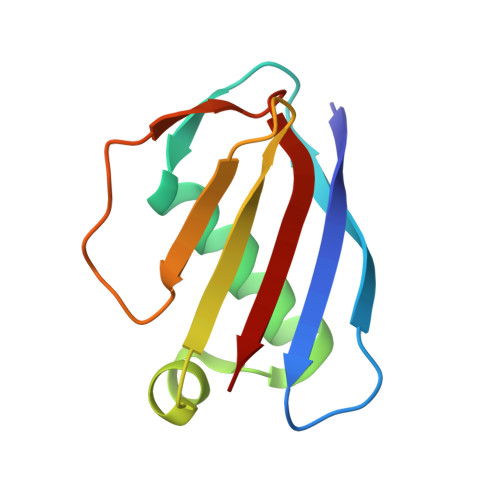The Crystal Structures of EAP Domains from Staphylococcus aureus Reveal an Unexpected Homology to Bacterial Superantigens.
Geisbrecht, B.V., Hamaoka, B.Y., Perman, B., Zemla, A., Leahy, D.J.(2005) J Biological Chem 280: 17243-17250
- PubMed: 15691839
- DOI: https://doi.org/10.1074/jbc.M412311200
- Primary Citation of Related Structures:
1YN3, 1YN4, 1YN5 - PubMed Abstract:
The Eap (extracellular adherence protein) of Staphylococcus aureus functions as a secreted virulence factor by mediating interactions between the bacterial cell surface and several extracellular host proteins. Eap proteins from different Staphylococcal strains consist of four to six tandem repeats of a structurally uncharacterized domain (EAP domain). We have determined the three-dimensional structures of three different EAP domains to 1.8, 2.2, and 1.35 A resolution, respectively. These structures reveal a core fold that is comprised of an alpha-helix lying diagonally across a five-stranded, mixed beta-sheet. Comparison of EAP domains with known structures reveals an unexpected homology with the C-terminal domain of bacterial superantigens. Examination of the structure of the superantigen SEC2 bound to the beta-chain of a T-cell receptor suggests a possible ligand-binding site within the EAP domain (Fields, B. A., Malchiodi, E. L., Li, H., Ysern, X., Stauffacher, C. V., Schlievert, P. M., Karjalainen, K., and Mariuzza, R. (1996) Nature 384, 188-192). These results provide the first structural characterization of EAP domains, relate EAP domains to a large class of bacterial toxins, and will guide the design of future experiments to analyze EAP domain structure/function relationships.
- Department of Biophysics and Biophysical Chemistry, The Johns Hopkins University School of Medicine, Baltimore, MD 21205, USA.
Organizational Affiliation:
















